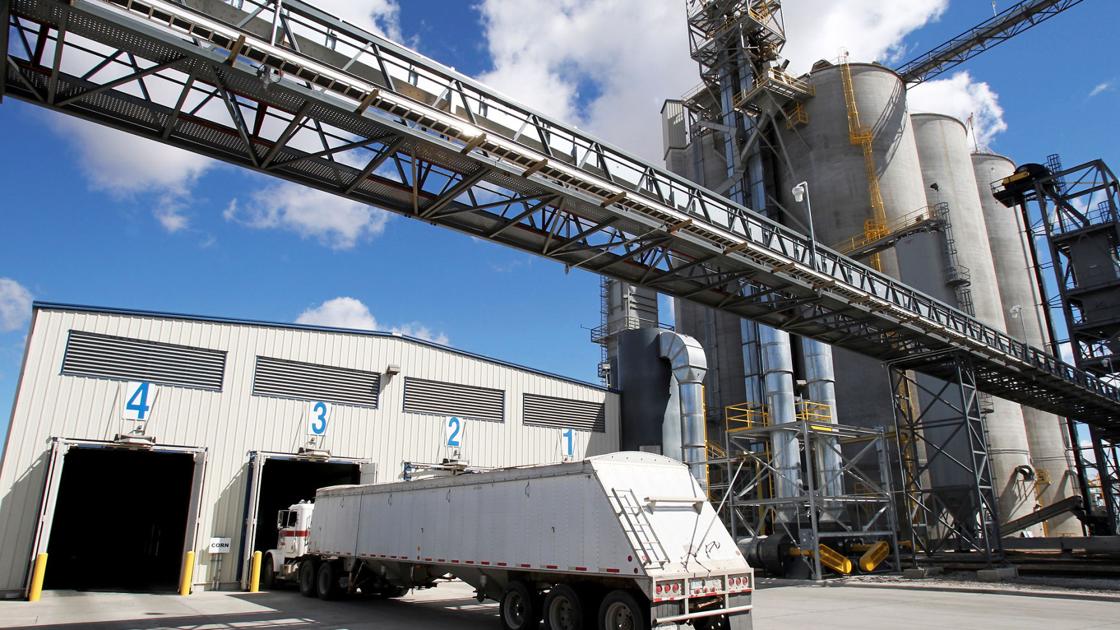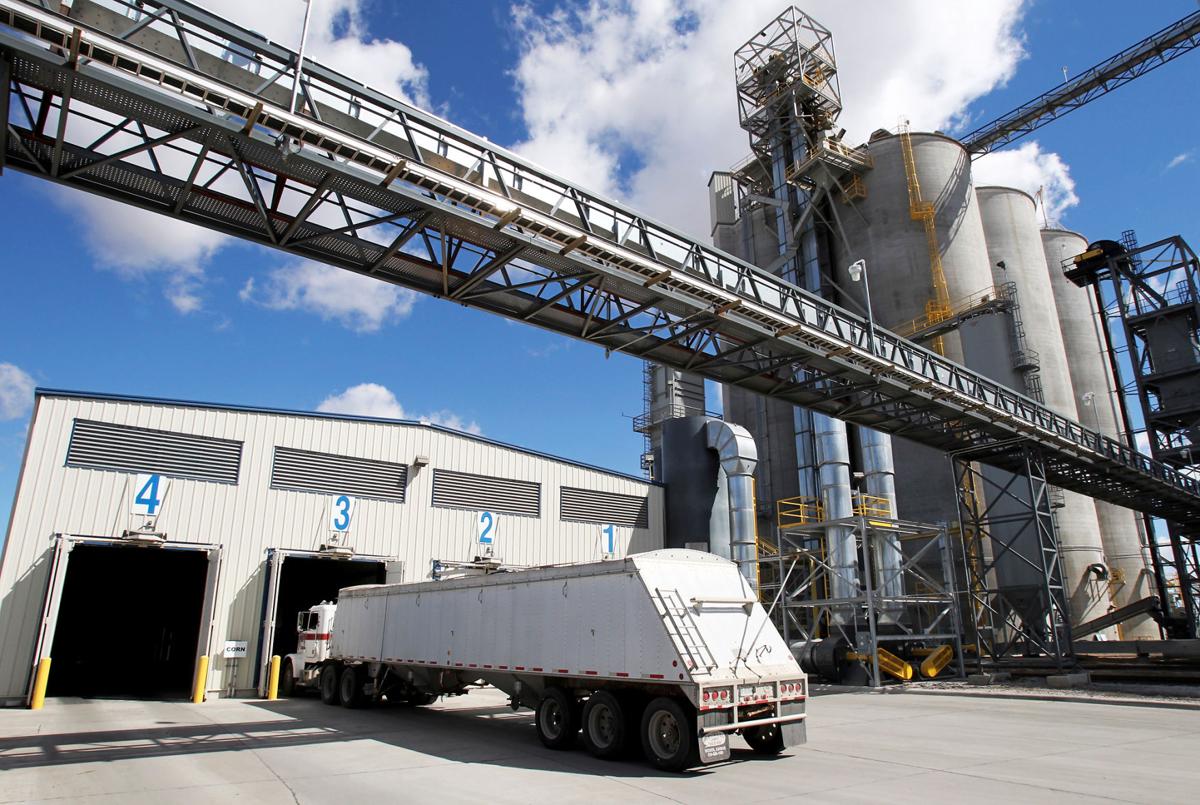

A truck pulls into one of four unloading bays as area farmers bring grain to the Aurora West ethanol plant west of Aurora in this 2011 file photo. (Independent/Barrett Stinson)
Despite the challenges of the pandemic, markets, trade and weather, the U.S. Department of Agriculture said that Nebraska’s 2020 corn crop is forecast at a record 1.82 billion bushels, up 2% from last year’s production.
Nearly every year, the state’s corn production has increased. In 2000, Nebraska farmers harvested 1.014 billion bushels of corn, compared to this year’s 1.82 billion bushels.
As trade has not been able to increase enough to take care of the growing productivity of American corn producers, farmers found another market for their corn — ethanol. Nebraska now has the capacity of producing more than 2 billion gallons of corn ethanol annually.
In recent years, there has been a push to increase the amount of ethanol in gasoline from 10% to 15% or 20%. The American Corn Growers Foundation would like to see policymakers raise that amount to 30%.
According to Gale Lush, ACGF chairman and a farmer from Wilcox, an article in the Nov. 17 edition of World Grain, titled “COVID-19’s lasting impact,” cites a Rabobank report, “The Grain and Oilseed Sector in a Post-COVID-19 World,” that “should serve as a warning to corn growers, farm organizations and policymakers in Congress that it’s time to ratchet up ethanol blending under the RFS to 30% nationwide as soon as possible.”
According to the Rabobank report, as more and more people are working from home, there will be less business travel, less vacation travel and more virtual events and meetings, which makes for a “grim long-term picture for the biofuels industry.”
Lush said the report said that “in recent years we’ve been seeing a slow decrease in corn demand for ethanol in the U.S.”
“That’s been fueled by a couple things, including more fuel-efficient cars, more electric cars and an overall decrease in demand for gas and oil products,” he said. “That trend was already in place and it’s not going away. If anything, it might accelerate. America needs a 30% ethanol blend to offset that trend.”
Lush said that “ethanol is an environmentally friendly, octane enhancing, job creating economic superstar that offers massive benefits for the rural sector and the American economy overall.”
According to a May fact sheet from Growth Energy:
— Thanks to ethanol, there are fewer toxic, dirty chemicals in the U.S. fuel supply, water and air.
— Biofuels, such as ethanol, play a major role in cleaning up our transportation sector and displacing harmful fuel additives, like benzene, toluene, ethylbenzene, and xylene (BTEX) that can be found in petroleum-based fuels.
— USDA data shows that ethanol reduces greenhouse gas emissions by 39% or more compared to traditional gasoline, with corn ethanol’s relative carbon benefits reaching as high as 70%.
— Research conducted in five global cities by the University of Illinois at Chicago found that E10 ethanol blends cut toxic emissions by 15.2%, while E20 blends reduce blends reduce toxins by 31.7%.
— A study done by researchers at the Ford Motor Company found that ethanol blends above 30% cut particle emissions by as much as 45%.
Lush also said that China’s State Council is encouraging all farmers to increase grain production with the planting of wheat, corn and rice.
“So, the large U.S. corn exports to China that have been in the news lately may not be ongoing, as some grain analysts might hope,” he said.
Lush said that with history as a teacher, “We better not count on exports to China to save our farm sector. Recent trade wars prove that reality. The new Biden administration is going to push for more renewable energy. Ethanol is a perfect fit to help rebuild and modernize the U.S. motor fuel infrastructure.”
Dan McGuire, ACGF policy director, points out that USDA’s November World Agricultural Supply Demand Estimate report projects that marketing year 2020-21 corn use for ethanol is only at 5.05 billion bushels, a major drop from 5.5 billion bushels used per marketing year in recent years.
McGuire said that same report projects FY 2020/21 corn year ending stocks at 1.702 billion bushels and average farm prices of only $4 per bushel.
“China is a major importer of U.S. corn in the near term due to a tremendous reduction in their domestic grain production and supply,” he said.
McGuire said, according to a Nov. 12 Reuters article, “China’s grain buying has accelerated since May as Beijing burned through once-huge stockpiles and as extreme weather damaged this year’s corn crop.”
He said that explains why China is importing so much U.S. corn and U.S. prices have risen a little.
McGuire said the USDA’s Foreign Agricultural Service reports that China’s corn imports are estimated to hit 22 million metric tons (867 million bushels), demand met by the U.S., Ukraine and other suppliers.
Even if China buys 500 million bushels of U.S. corn, he said it will only temporarily offset one year’s lost domestic U.S. ethanol demand.
McGuire said the Biden administration must reverse EPA’s RFS ethanol blending waivers for oil companies and push for a 30% ethanol blend in gasoline nationwide.
He said no-till/low-till practices and cover crops make corn ethanol a value-added product of modern, regenerative farming.
“Ethanol is a pro-environment, renewable energy strategy,” McGuire said.
Subscribe to our Daily Headlines newsletter.
November 28, 2020 at 08:00PM
https://ift.tt/3q5e38V
American Corn Growers Foundation to policymakers: Ratchet up ethanol blend to 30% - Grand Island Independent
https://ift.tt/3gguREe
Corn

No comments:
Post a Comment